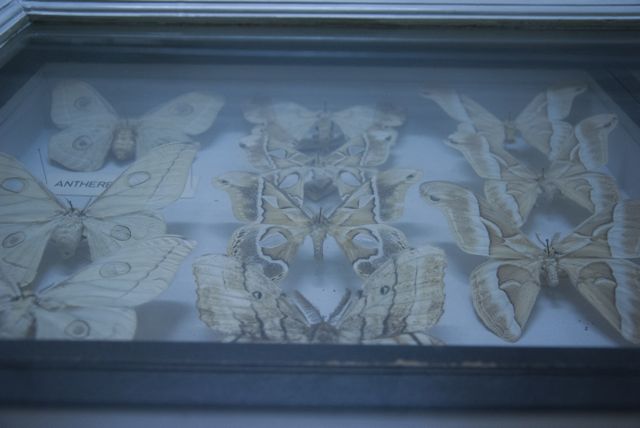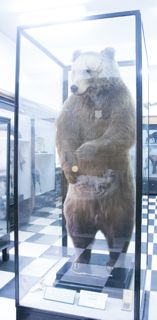Photos: Polina Spartyanova
Polina Spartyanova
The first and richest museum of natural history in the Balkan Peninsula is the National Museum of Natural History at the Bulgarian Academy of Sciences in Sofia. One can see there over one million representations of stuffed animals, plants and minerals that promote animate and inanimate nature in Bulgaria and abroad. The exhibition at the oldest Bulgarian museum includes more than 400 species of mammals, more than 12,000 species of birds, a large number of amphibians and reptiles, hundreds of thousands of insects and other invertebrates as well as numerous bone fragments of various species.

The National Museum of Natural History was founded in 1889 as a Natural History Museum of Prince Ferdinand I, who was the head of the Bulgarian state from 1887 to 1918. Initially, the museum housed the private collection of butterflies, birds and mammals of the Bulgarian monarch who was a passionate botanist, entomologist and philatelist. For 30 years, Ferdinand I covered the cost of the museum with his own funds and added valuable species from different continents to its collections.

Due to his discoveries of new species of butterflies and plants, he was elected as a member of numerous scientific societies in Europe as well as an honorary member of the German Ornithological Society. However, the most intensive development of the museum was under the guidance of Dr. Ivan Buresh, who was its director from 1914 to 1959 when he organized many expeditions to all Bulgarian mountains and the Balkan countries to enrich the museum collections. Many new species of animals and plants of the biological world were discovered in this period, which had not hitherto been the subject of human studies and thus the National Museum of Natural History became the primary unit for research in the field of natural sciences in Bulgaria.
Today, the museum is situated on four floors in the centre of Sofia and its visitors can learn about every aspect of animate and inanimate nature, not only from within the borders of Bulgaria but beyond. The first part of the natural science exposition is dedicated to minerals and mineralogy, and to the mineral forming process. Here the windows are brand new and well maintained unlike the larger part of the National Museum of Natural History.
 The second part displays stuffed birds and models of amphibians, fish, fossils and more. In the room with the birds, visitors can learn about almost all species of birds living today in Bulgaria and around the world, but will not have the impression that they look just like those depicted in encyclopaedias. Many of these stuffed birds have lost their colour over time or are covered with dust due to poor maintenance. I asked the museum management why good care is not taken of this especially valuable collection, which includes the Caroline parrot that disappeared at the beginning of the 20th century, and they said that "not all stuffed animals can be in the best condition at any one time due to understaffing." However, my question remained unanswered, because while I was visiting the last part of the museum and the hall of insects I witnessed how one of the clerks was "watching over" the hall, occupied with her mobile phone and with her feet on the table.
The second part displays stuffed birds and models of amphibians, fish, fossils and more. In the room with the birds, visitors can learn about almost all species of birds living today in Bulgaria and around the world, but will not have the impression that they look just like those depicted in encyclopaedias. Many of these stuffed birds have lost their colour over time or are covered with dust due to poor maintenance. I asked the museum management why good care is not taken of this especially valuable collection, which includes the Caroline parrot that disappeared at the beginning of the 20th century, and they said that "not all stuffed animals can be in the best condition at any one time due to understaffing." However, my question remained unanswered, because while I was visiting the last part of the museum and the hall of insects I witnessed how one of the clerks was "watching over" the hall, occupied with her mobile phone and with her feet on the table.
Many species of amphibians inhabiting Bulgaria and foreign countries, which are presented in the next part of the museum, are displayed in glass cases but there are models of larger species as well. The models of some of the amphibians probably were extremely impressive 20-30 years ago but today they are rather an imitation designed to satisfy the curiosity of the youngest visitors. In the hall of fish, visitors can see different species inhabiting the Bulgarian freshwater basins and others that are characteristic of the Black Sea. The collection contains fish from the Mediterranean and the Red Sea, and various species of molluscs.
 The third part of the museum is devoted to mammals and it presents different groups of primates, predators, hoofed animals and many other species from almost all continents of the world. The exhibits in this hall are well maintained and they enjoy the greatest visitor interest. One of the most interesting mammals is the two-metre-long bear from Rila Mountain, standing on its hind legs, which, at the international hunting exhibition in Berlin in 1937, won a gold medal for the biggest bear. This part of the museum displays its latest exhibit, the Siberian tiger, which is the biggest among the tiger subspecies and also the largest representative of the cat family. This species is now almost extinct and therefore the National Museum of Natural History has made strenuous efforts to obtain this exhibit.
The third part of the museum is devoted to mammals and it presents different groups of primates, predators, hoofed animals and many other species from almost all continents of the world. The exhibits in this hall are well maintained and they enjoy the greatest visitor interest. One of the most interesting mammals is the two-metre-long bear from Rila Mountain, standing on its hind legs, which, at the international hunting exhibition in Berlin in 1937, won a gold medal for the biggest bear. This part of the museum displays its latest exhibit, the Siberian tiger, which is the biggest among the tiger subspecies and also the largest representative of the cat family. This species is now almost extinct and therefore the National Museum of Natural History has made strenuous efforts to obtain this exhibit.
In the fourth part of the National Museum of Natural History, there are insects arranged in 20 glass cases, that are very well preserved. The collection of stuffed butterflies is perhaps the most beautiful of all the museum exhibits because it is well preserved and their colours are still bright and gay, although some of them were part of the Prince’s collection. In addition, you can see different types of bugs and insects from various parts of the world.